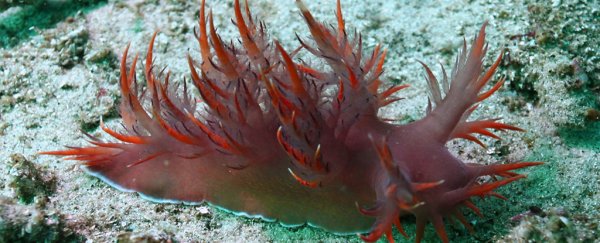Species that share similar kinds of brain anatomy have been caught using different neural circuits to perform identical behaviours, and it challenges a basic assumption on the relationship between behaviour and neurology.
The team is yet to figure out why this strange overlap exists among species, but the discovery points to how important behaviours can be retained as certain animals evolve.
Scientists at Georgia State University based their conclusions on their studies involving two different species of marine animal called a nudibranch.
If you're yet to have the pleasure of seeing these amazing molluscs, nudibranches are an incredibly diverse group of gastropod that resemble a cross between a Pokémon and sea slugs.
They can be found all over the globe, and are often shapes and adornments with a rich variety of shapes and adornments.
The lion's mane nudibranch (Melibe leonina) is a 10 centimetre (about 4 inch) long, translucent, slug-like animal with a fringed hood that's used to catch prey.
Then there's the giant nudibranch (Dendronotus iris), which varies between 10 and 30 centimetres (4 inches to a foot) in length, with a branching hood and a body covered in spiny-looking protrusions.
One thing these two species happen to have in common is the way they swim - both flatten themselves a little like a fish, and flex their bodies side to side in bursts for several seconds to get from one place to another.
These closely related species moving in identical ways isn't surprising, nor is the fact that both have simple nervous systems with similar kinds of neurons in much the same positions.
It's easy to see why biologists would assume the neural circuits for this basic side-to-side squirming behaviour in Melibe leonina would be the same circuits for the same behaviour in Dendronotus iris.
But as Paul Katz from the Neuroscience Institute at Georgia State University as his team discovered, they're not.
Previous research by Katz and his colleagues had already shown that in spite of having the same basic brain structures, each species of nudibranch used a different arrangement of pathways between neurons to achieve the same swimming pattern.
So the big question was whether it was possible to rewire the brain of one nudibranch to match the pattern of neural connections in the other nudibranch and observe the same behaviour.
The team used a toxic plant extract called curare to block individual connections between neurons in the giant nudibranch, preventing its brain from producing the sequence of impulses that would allow it to swim.
They then used electrode implants to artificially simulate the connections between the brain cells of the hooded nudibranch.
This allowed the giant nudibranch to swim again, only this time using the same neurons in a completely different way.
"This and previous studies show that connectivity of the neural circuits of two different species of sea slugs differ substantially from each other despite the presence of homologous neurons and behaviours," says Katz.
The results indicate deviations in small scale 'microcircuitry' between groups of neurons could lead to the evolution or conservation of certain behaviours.
In other words, if a behaviour is important, the brain can devise new circuits to keep it, without needing to develop whole new bits of anatomy.
At this stage, it's not yet clear why the two species have used their neurons to do the same thing in two different ways.
"Perhaps some of the neurons in one or the other species have taken on additional functions that provide selective pressure to alter the ancestral connectivity," the researchers suggest.
On the other hand, maybe neither pattern makes any difference, and it's a nervous system equivalent of genetic diversity 'drifting' in different directions.
In any case, the take-home message seems to be that just because two species seem to behave the same and have the same neural anatomy, it doesn't necessarily mean they're using them in exactly the same way.
This research was published in the Journal of Neurophysiology.
